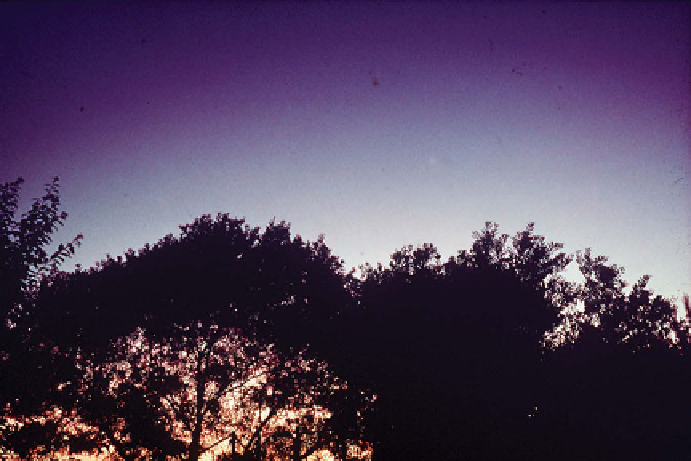Geoscience Reference
In-Depth Information
Figure 7.29.
Purple sunset observed from Palos Verdes, California, following the 1982 El Chichon volcanic
eruption. Photo by Jeffrey Lew, UCLA.
aerosol particles on visibility degradation and UV light
reduction. Processes affecting radiation through the air
include absorption and scattering. Gas absorption of UV
radiation is responsible for the stratospheric inversion
and most photolysis reactions of gases. Gas absorption
of visible light is important only when NO
2
(g) mixing
ratios are high. Gas (Rayleigh) scattering affects only
UV and visible wavelengths. The most important gas
scatterers are molecular oxygen and molecular nitrogen.
All aerosol particles absorb near- and thermal-IR radia-
tion, but only a few, including black carbon and certain
soil components, absorb visible (including UV) radia-
tion. Several organic aerosol components, particularly
nitrated and aromatic compounds, preferentially absorb
UV radiation, causing UV and ozone reductions in pol-
luted air. All aerosol components scatter radiation. The
most important visibility-degrading processes in pol-
luted air are particle scattering, particle absorption, gas
absorption, and gas scattering, in that order. In clean air,
visibility is limited in the horizontal to a few hundred
kilometers by gas scattering.
the incident light to be reduced by 99 percent due to
absorption?
7.2. If the angle of incidence, relative to the surface nor-
mal, of 0.5-
m-wavelength light entering water from
the air is 30 degrees, determine the angle of refraction
in the water.
7.3. If 0.5-
m-wavelength light travels from water to
air, what angle of incidence (with respect to the surface
normal in water) is necessary for the angle of refraction
to be 90 degrees? This angle of incidence is referred
to as the critical angle. What happens if the angle of
incidence in water exceeds the critical angle?
7.4. If gas molecules in the atmosphere preferentially
scattered longer wavelengths over shorter wavelengths,
what colors would you expect the sky and the sun to be
at noon, afternoon, and sunset?
7.5. Explain why nitrogen dioxide gas causes more vis-
ibility reduction than does ozone gas.
7.6. Calculate the meteorological range at 0.55
m
resulting from aerosol particle (a) scattering alone;
(b) absorption alone; and (c) absorption plus scat-
tering, assuming the atmosphere contains 10
4
7.5. Problems
7.1. Calculate the fractional transmission of radiation
through a swimming pool 2.0 m deep at a wavelength
of 0.5
parti-
cles cm
−
3
of 0.1-
m-diameter spherical particles made
of black carbon. Use Figure 7.20 to obtain single-
particle
mwhen only absorption of light by liquid
water is considered. At what water depth do you expect
absorption
and
scattering
efficiencies,
and


Search WWH ::

Custom Search